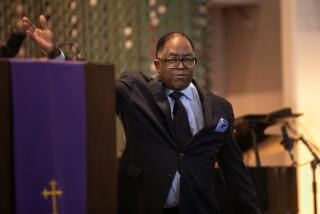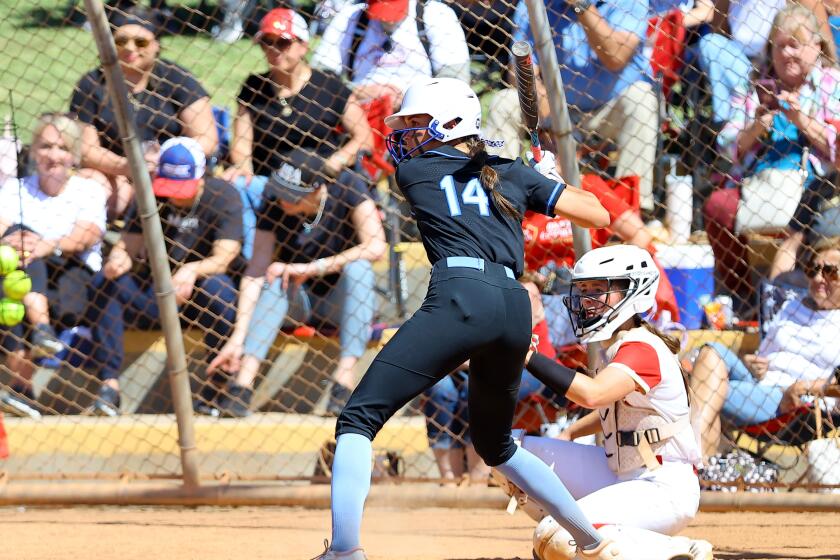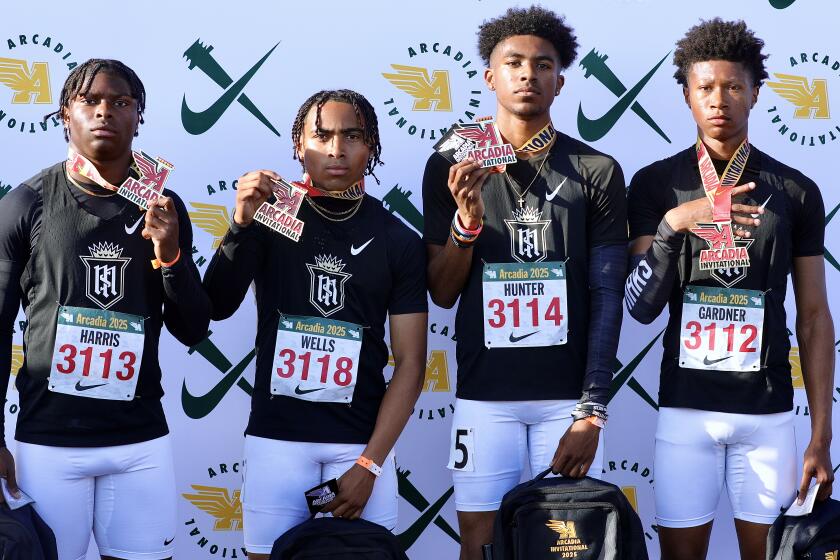Nobody Is Doubting Thomas : Penn State: Whenever All-American running back Blair Thomas has had to prove himself, he has done so.
- Share via
SAN DIEGO — The eyes stare straight ahead. He shifts uncomfortably in his chair. His mind seems to be racing for an answer.
Instead, he smiles uneasily, shrugs his shoulders and doesn’t utter a sound.
In five months, Blair Thomas likely will be a millionaire. He’s expected to be one of the first running backs selected in the first round of the National Football League draft, and by the time he signs his four-year contract, he should bring down at least $2.5 million, maybe more than $3 million.
So when he is asked if he feels grateful for everything that is happening to him, why does he have such difficulty spitting out an answer?
After all, he always hears how blessed he is with athletic talent. He listens to those who say how lucky he was to have gotten such a fine education at Penn State. He hears alumni babble about how their illustrious football program gave a ghetto kid the opportunity of a lifetime.
Blair Lamar Thomas knows better.
He hasn’t been handed one damn thing in this life that wasn’t the result of good, old-fashioned hard work.
Except the virtue of perseverance.
“There were a lot of times I could have stopped and felt sorry for myself,” says Thomas, who will be showcased in tonight’s Sea World Holiday Bowl. “But that’s not me.
“Life is full of obstacles. I know I’ve had my share. Maybe more than my share.
“But that’s what life’s all about, isn’t it, overcoming the odds?”
Paterno debated for days what to do, but when it came down to it, he said, he had no choice.
He knew it would break the kid’s heart.
Hell, it was breaking his own heart.
But after two years of recruiting Thomas, and finally luring him to Penn State, Paterno was making the three-hour drive to Philadelphia to tell Thomas that he couldn’t give him a scholarship after all.
“I just didn’t think I could take him after I saw his college board scores,” Paterno said. “I went to see his coach, trying to get a way out of this thing.”
Paterno walked into Al Angelo’s office at Frankford High School and explained that Thomas qualified for entrance to Penn State. And certainly, no coach in his right mind would turn down a chance to have a Blair Thomas in his backfield. But after seeing those scores, well, Paterno didn’t think Thomas would be able to cut it.
Angelo, who has won 11 Philadelphia Public League championships, listened to all of this and understood Paterno’s concerns. But now it was his turn to talk.
He told Paterno that Blair Thomas was the hardest-working, most-conscientious athlete he ever had. OK, maybe Thomas was no genius, but he wasn’t a dummy, either. He could handle the school work. Just be patient.
Besides, there was oh so much more to this kid than school work. Anyone can stay up studying and doing book reports, but how many kids did Paterno have who were willing to conquer the elements of his environment as Thomas had?
Thomas, born and raised in the ghetto of North Philadelphia, living just a few blocks away from the old Connie Mack ballpark, didn’t go to high school with the rest of the kids in the neighborhood. His mother wanted him to have a better education, so instead of going to Gratz High around the corner, he attended Frankford.
So Thomas would get up at 6 every morning. Take one bus for three or four miles. Switch buses and ride another for two. Get off and board the L-train and five stops later arrive at Frankford.
“It seemed like it took about two hours every day,” Thomas said, “but it was about a 45-minute ride in all.”
Thomas went to all of his classes, stayed after school for football practice in the fall and track practice in the spring, and rode those trains and buses every night before finally getting home at about 8.
“I used to feel so sorry for him, standing out there in the cold and waiting for those buses every night,” Angelo said. “I hated to see a kid go through those neighborhoods at night.
“But you know something, not once was that kid ever late to one of my practices. Not once did he even miss a practice. He didn’t even skip a class his whole time here.
“It didn’t take long to figure out he was a whole lot different from the others.”
Man, you talk about athletic talent. The first time Thomas ever put on a football uniform was his first game in high school. They don’t have Pop Warner or Little Leagues where Thomas grew up.
“It’s a bad neighborhood,” Thomas said. “We’d play football, but it was in the street. A lot of the guys my age didn’t want to play, because you can get cut up pretty good getting tackled on the asphalt, so I always played with the older guys.”
When Thomas finally got the chance to play on an actual football field, with a uniform and everything, he was so excited that he scored six touchdowns in his first game. By the time he completed high school, he had gained 3,941 yards, scoring 59 touchdowns.
It’s funny, but when Angelo relates his favorite Thomas anecdote, it doesn’t involve football.
It was Thomas’ junior year. He was running track but had suffered a pulled hamstring and was going to be out for two months.
“He still wanted to stay on the team,” Angelo said, “so I said, ‘Blair, go try the shotput.’ He didn’t even know what that was. I said, ‘That iron ball laying over there.’
“Well, he threw it around a couple of times before the Philadelphia Public League Championships. We get in the meet, and what does he do, he throws the thing 52 feet, a school record.
“You know, people still talk about that day.”
Paterno listened to all of this. He talked to the school principal and was told that Thomas had passed all of his classes. He talked to the counselors and found out that he was one of the most popular kids in school. He talked to Thomas’ mother, who said that if Blair messed up in any classes at Penn State, she’d be on the first bus to State College for a talk.
“They all convinced me he could do it,” Paterno said. “Every one of them said just give him a try, coach. So I did.”
Thomas will graduate Jan. 6 with a degree in recreation and parks in the College of Health and Human Development.
When Thomas goes back home to Philadelphia during school breaks, he inevitably finds himself at the corner of 34th and Lehigh.
He usually goes there by himself, just to be alone with his thoughts, alone with his prayers.
In front of him are two graves with headstones, side by side.
One belongs to his father, LeRoy, who died of stomach cancer in November 1987.
The other belongs to his older brother, Lawrence, who died of a heart attack attributed to a drug overdose in February 1988.
“You think about things like that,” Thomas said, speaking almost in whisper, “and then you realize it’s crazy to think you got things so bad.
“What happened to me is nothing. I’m alive. My brother and father are next to each other in graves.”
What happened to Thomas is unveiled when he rolls up his right pant leg. There, at the knee, are two scars. On one side is a six-inch scar that starts below the knee, on the other a four-inch scar that starts above it.
It was just a bunch of guys fooling around on the field at State College that Dec. 11 afternoon. Thomas was preparing for the Citrus Bowl when he planted his right leg and tried to cut to his left. And instead dropped to the dirt.
“It was weird,” he said, “it sounded like somebody was cracking their knuckles.”
Thomas got up, went to the trainer’s room for ice and figured he’d be OK by morning.
The swelling and discoloration told Thomas that this was something serious. He went to the trainer’s room for an examination. X-rays were taken. Doctors confirmed the worst: a torn anterior cruciate ligament.
No, it couldn’t be, Thomas kept telling himself. He went to Philadelphia for a second opinion and Los Angeles for a third. The tests all revealed the same thing.
Thomas had never broken a bone before in his life. Oh, he has had his share of bumps and bruises at Penn State, but never anything that kept him out of a game.
He underwent surgery at the Hershey Medical Center. Doctors removed his patellar tendon from his lower leg and inserted it into his knee, reconstructing the ligament.
Thomas asked when he could come back. Doctors told him it would be at least eight to 12 months. Thomas didn’t believe them and told everyone who’d listen that he’d be ready for his senior season in 1988. The team needed him, and after rushing for the third-highest total in Penn State history and leading the team in receiving, he wasn’t going to just stand by on the sidelines.
He did everything he possibly could. He was in the weight room every day. He was running up and down the the bleachers. It was no use. By the third game, he knew he could not play.
“You know, the toughest part of the whole thing was having to listen to everybody ask about my knee,” he said. “Every day, it was the same thing. ‘Blair, how’s the knee?’ ‘Hey, how’s that ol’ knee doing?’
“Everyone was asking so much about the knee that no one asked, ‘Hey, how’s Blair doing?’ ”
Thomas went to every practice and all but two games but sat out the whole season. He was eligible for the 1989 NFL draft, but on the one-year anniversary of his operation, he announced that he would return to Penn State.
“I really had no choice,” Thomas said. “No one really believed I was healthy, and I had nothing to show them that I was back. So I probably wouldn’t have even been drafted very high. I had to come back. I had to prove that I was the same Blair Thomas as I was before.”
Paterno used him cautiously in the first six games, allowing him to carry the ball more than 21 times only once. That was the easy part of the schedule, anyway. Now, in the heart of it, it was time to unleash him.
Alabama: 35 carries, 160 yards.
West Virginia: 32 carries, 150 yards.
Maryland: 26 carries, 125 yards.
Notre Dame: 26 carries, 133 yards, two touchdowns.
Pittsburgh: 30 carries, 131 yards.
Thomas finished with 1,341 yards, just 97 yards shy of Curt Warner’s school record. Thomas didn’t care about any records. He had something to prove, and when he was selected All-American for the second time, the doubts ended.
“Blair’s return meant more to us than just his physical ability,” Paterno said. “We have not had a player in my 40 years who works any harder, practices any harder, is more committed, more loyal and better-liked than Blair Thomas.
“I’m saying it now, and I’ll probably say it 20 years from now, Blair Thomas is the finest all-around tailback we’ve ever had.”
Even though Angelo never has had an All-American, or someone who has played in the NFL, he refuses to say Blair Thomas is the best player he ever coached.
What he will say, however, is that Blair Thomas is the finest human being he ever coached.
“He’s got an attitude and an outlook on life that’s just beautiful. You won’t see him running around holding his finger up saying, ‘We’re No. 1’ or any of that crap. You won’t hear him crying about all of the bad breaks that have happened in his life.
“What you will see is a guy who doesn’t talk a whole lot, keeps his emotions to himself, and does everything he can to make you proud that he’s your friend.
“That’s Blair Thomas.”
More to Read
Go beyond the scoreboard
Get the latest on L.A.'s teams in the daily Sports Report newsletter.
You may occasionally receive promotional content from the Los Angeles Times.










